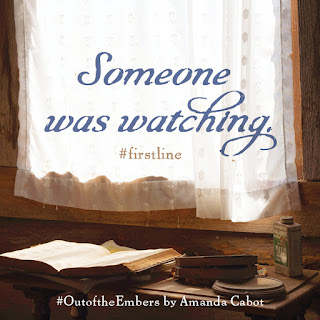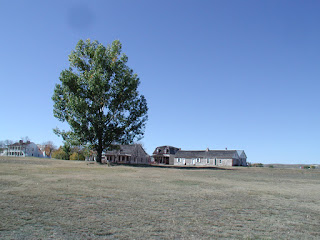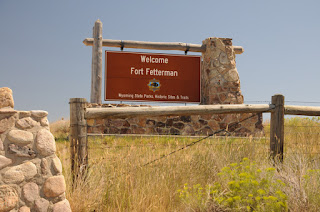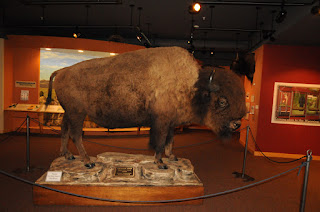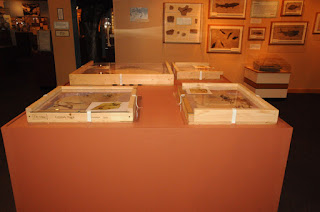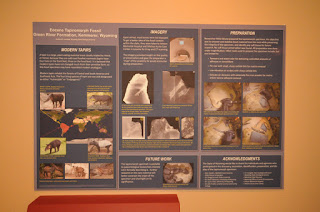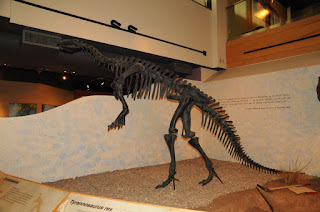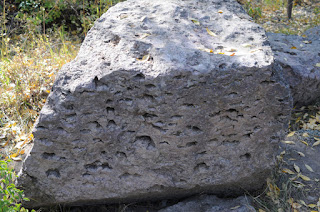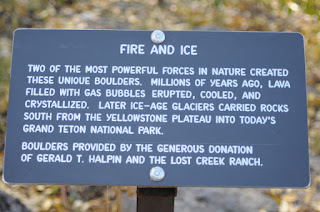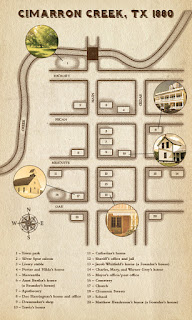Of course there's more to life than raising horses, but Wyatt's mother wants to be sure that he, who just so happens to be the hero of Out of the Embers, knows that.
What does she want him to do? Marry and give her grandchildren.
Will he? Maybe.
More information.
Monday, December 30, 2019
Wednesday, December 25, 2019
Wednesday in Wyoming - December 25, 2019
It's Christmas Day -- the perfect day to share this simple but meaningful reminder of what we're celebrating.
Monday, December 23, 2019
Out of the Embers Countdown - Ten Weeks
It's ten weeks -- oh, all right, let's be precise. It's ten weeks and one day, before Out of the Embers is released. Since Revell created some wonderful memes with quotes from the book, I thought it would be fun to do a countdown with those quotes.
We're starting with the first line. Did this hook you? I hope so.
And, if you'd like more information or buying links, here's a link.
We're starting with the first line. Did this hook you? I hope so.
And, if you'd like more information or buying links, here's a link.
Wednesday, December 18, 2019
Wednesday, December 11, 2019
Wednesday in Wyoming - December 11, 2019
This is one house I drive by every year, simply because I love the fact that their decorations are a nativity scene, complete with Wise Men as well as shepherds, rather than Santas and snowmen.
Clearly, they understand the reason we celebrate Christmas.
Clearly, they understand the reason we celebrate Christmas.
Wednesday, December 4, 2019
Wednesday in Wyoming - December 4, 2019
This one, outside a church, has a timeless message, doesn't it?
Wednesday, November 27, 2019
Wednesday in Wyoming - November 27, 2019
For me, these wagon ruts are among the most memorable sights along the Oregon Trail. Can you imagine how many wagons must have traveled this route to carve ruts that deep? While it's true that limestone is a relatively soft rock, it's still rock.
Amazing!
The ruts are now preserved as a Wyoming state historic site.
Amazing!
The ruts are now preserved as a Wyoming state historic site.
Labels:
oregon trail,
wagon ruts,
Wednesday in Wyoming
Wednesday, November 20, 2019
Wednesday in Wyoming - November 20, 2019
One of the major landmarks on the Oregon Trail was Laramie Peak. Although it's not the highest mountain in Wyoming, it is the highest peak in the Laramie Range and is high enough to be seen from up to 100 miles away.
As beautiful as the mountain is, it probably filled pioneers with at least a bit of dread, since it signaled the most difficult part of the journey.
If you'd like to learn more about Laramie Peak, Wikipedia has an article.
While I was searching for information about the peak, I discovered that it's a popular climbing spot. So, if you're a climber and are coming to Wyoming, here's that link. I plan to stay on level ground.
As beautiful as the mountain is, it probably filled pioneers with at least a bit of dread, since it signaled the most difficult part of the journey.
If you'd like to learn more about Laramie Peak, Wikipedia has an article.
While I was searching for information about the peak, I discovered that it's a popular climbing spot. So, if you're a climber and are coming to Wyoming, here's that link. I plan to stay on level ground.
Labels:
laramie peak,
oregon trail,
Wednesday in Wyoming
Wednesday, November 13, 2019
Wednesday in Wyoming - November 13, 2019
One of the major stops on the Oregon Trail was Fort Laramie. It was here that pioneers could purchase supplies for the next part of the journey -- the most challenging part, because it involved mountains. They could also have their wagons repaired, do laundry, and -- perhaps most importantly -- rest for a day or two before continuing.
The picture above shows modern day Fort Laramie, with a number of restored buildings, including the sutler's store, which is the one-story building on the far right. It was here that pioneers would shop for whatever they needed.
As you can see, the interior of the sutler's store was filled with goods that pioneers as well as soldiers might need. Everything from saddles to teakettles to blankets and, of course, food, could be purchased here.
To learn more about Fort Laramie, click here.
The picture above shows modern day Fort Laramie, with a number of restored buildings, including the sutler's store, which is the one-story building on the far right. It was here that pioneers would shop for whatever they needed.
As you can see, the interior of the sutler's store was filled with goods that pioneers as well as soldiers might need. Everything from saddles to teakettles to blankets and, of course, food, could be purchased here.
To learn more about Fort Laramie, click here.
Wednesday, November 6, 2019
Wednesday Near Wyoming - November 6, 2019
This month, in honor of the fact that Barbour Books has reissued The Oregon Trail Romance Collection, which includes my novella, The Sagebrush Bride, in a bargain print edition, I'm featuring scenes along the Oregon Trail.
As I drive in air-conditioned or heated comfort along reasonably smooth roads with speed limits as high as 80 mph, I marvel at all that the pioneers endured on their journey west. Many of them walked next to their wagons, facing blistering heat, hail storms, possible snake bites - so many hazards. But they persisted, taking comfort from milestones along the way.
One of those milestones was Chimney Rock, which is now a National Historic Site in Nebraska. (That's why this week's post is Wednesday NEAR Wyoming.) For more information about Chimney Rock, you might enjoy this link.
Labels:
chimney rock,
oregon trail,
Wednesday in Wyoming
Wednesday, October 30, 2019
Wednesday in Wyoming - October 30, 2019
Did you ever doubt the power of the wind in Wyoming? If so, consider the way the aspen's trunk is bent.
Just another beautiful scene in the Snowy Range.
Just another beautiful scene in the Snowy Range.
Wednesday, October 23, 2019
Wednesday in Wyoming - October 23, 2019
Although we couldn't go all the way to Brooklyn Lake, thanks to the unseasonable snow in the Snowy Range, we did see a number of smaller lakes, including Little Brooklyn Lake.
Beautiful!
Beautiful!
Wednesday, October 16, 2019
Wednesday in Wyoming - October 16, 2019
Here's something you don't see in too many parks - a chapel.
That was one of the pleasant surprises along the road to Brooklyn Lake in the Snowy Range.
That was one of the pleasant surprises along the road to Brooklyn Lake in the Snowy Range.
Wednesday, October 9, 2019
Wednesday in Wyoming - October 9, 2019
The plan for our mid-July trip to the Snowy Range had been to drive to Brooklyn Lake, hike around the lake, and admire the wildflowers. Unfortunately, the Snowies lived up to their name, and - to my surprise - a number of the side roads, including the one to Brooklyn Lake, were still impassible due to snow.
That was disappointing. What wasn't disappointing were the wildflowers. As you can see, they practically carpeted the area.
That was disappointing. What wasn't disappointing were the wildflowers. As you can see, they practically carpeted the area.
Wednesday, October 2, 2019
Wednesday in Wyoming - October 2, 2019
You may recall the Snowy Range from previous posts and that it got its name, not from snow, but from the white rocks.
I'd never been there during the summer but wanted to see the wildflowers, so in the middle of July, my husband and I headed that way.
As you can see, although the main road was clear, there was snow on the mountain tops. You can also see that this is quintessential Wyoming road -- no traffic, just lots of beautiful scenery.
Next week, you'll see the surprise that awaited us.
I'd never been there during the summer but wanted to see the wildflowers, so in the middle of July, my husband and I headed that way.
As you can see, although the main road was clear, there was snow on the mountain tops. You can also see that this is quintessential Wyoming road -- no traffic, just lots of beautiful scenery.
Next week, you'll see the surprise that awaited us.
Wednesday, September 25, 2019
Wednesday in Wyoming - September 25, 2019
This was one of my favorite exhibits at Fort Fetterman. While it may look like nothing more than bits of broken crockery and metal, it's actually a collection of items that visitors found on the grounds and brought to the curator.
Among other things, there are square nails, which are characteristic of the fort's construction, and a bottle with a round bottom. Why round? The stoppers were corks, and they needed to be kept moist. The round bottom meant that the bottles could not be stood on end, which could have resulted in dry corks.
Who would have guessed that?
Among other things, there are square nails, which are characteristic of the fort's construction, and a bottle with a round bottom. Why round? The stoppers were corks, and they needed to be kept moist. The round bottom meant that the bottles could not be stood on end, which could have resulted in dry corks.
Who would have guessed that?
Wednesday, September 18, 2019
Wednesday in Wyoming - September 18, 2019
This exhibit from the Fort Fetterman museum shows some of the tools that military doctors used there. Can you identify most of them?
Wednesday, September 11, 2019
Wednesday in Wyoming - September 11, 2019
Remember the officer's quarters in last week's post about Fort Fetterman? They're located in this restored duplex, which is now the fort's primary museum. (A former ordnance building houses the second museum.)
One of the most interesting aspects of this building, at least for me, was its modular construction. If you look at the following picture, you can see that there are four distinct sections to the building.
Another thing to note is that, while this is a duplex, the two halves are not identical. The one on the left has an extra window, suggesting that it would be assigned to a more senior officer.
Rank was extremely important in that era, particularly where housing was concerned. When a new officer was assigned to the fort, he was given the housing his rank merited, displacing the current lower-ranking occupant, who then displaced someone else. It was the military version of musical chairs.
One of the most interesting aspects of this building, at least for me, was its modular construction. If you look at the following picture, you can see that there are four distinct sections to the building.
Another thing to note is that, while this is a duplex, the two halves are not identical. The one on the left has an extra window, suggesting that it would be assigned to a more senior officer.
Rank was extremely important in that era, particularly where housing was concerned. When a new officer was assigned to the fort, he was given the housing his rank merited, displacing the current lower-ranking occupant, who then displaced someone else. It was the military version of musical chairs.
Wednesday, September 4, 2019
Wednesday in Wyoming - September 4, 2019
Have you ever heard of Fort Fetterman? If you're not a western history buff or a Wyomingite, you may not have, but it was a key staging point during the nineteenth century Indian Wars.
So, where is this fort? It's just a few miles outside of Douglas, Wyoming, which is right on Interstate 25. (I'm picturing you pulling out your maps or -- more likely -- using a mapping app to see where that is.)
Like many forts of that era, once Fetterman was decommissioned, the buildings were sold and dismantled, leaving little for future historians. But two of the original buildings have been restored and are open to the public from Memorial to Labor Day.
One of them, a former officer's housing duplex, includes this example of an officer's quarters. As you might expect, the precise placement of everything reflects the resident's military training.
If you're interested in learning more about the fort's history, here's a link you may find interesting. And be sure to come back next week to see more pictures of the fort.
So, where is this fort? It's just a few miles outside of Douglas, Wyoming, which is right on Interstate 25. (I'm picturing you pulling out your maps or -- more likely -- using a mapping app to see where that is.)
Like many forts of that era, once Fetterman was decommissioned, the buildings were sold and dismantled, leaving little for future historians. But two of the original buildings have been restored and are open to the public from Memorial to Labor Day.
One of them, a former officer's housing duplex, includes this example of an officer's quarters. As you might expect, the precise placement of everything reflects the resident's military training.
If you're interested in learning more about the fort's history, here's a link you may find interesting. And be sure to come back next week to see more pictures of the fort.
Wednesday, August 28, 2019
Wednesday in Wyoming - August 28, 2019
What do you think this bear is doing? Getting ready for a summer nap? Hoping to spot something to eat? Or maybe just climbing over the log?
All I know is that I smiled when I saw the statue, which is part of the Cheyenne Botanic Gardens' "Gardens Gone Wild" exhibit, featuring almost twenty of Dan Ostermiller's sculptures.
I've only shown you a few this month, but I hope you agree that it's an intriguing exhibit. Next month, we'll move outside of Cheyenne itself for our Wednesdays in Wyoming.
All I know is that I smiled when I saw the statue, which is part of the Cheyenne Botanic Gardens' "Gardens Gone Wild" exhibit, featuring almost twenty of Dan Ostermiller's sculptures.
I've only shown you a few this month, but I hope you agree that it's an intriguing exhibit. Next month, we'll move outside of Cheyenne itself for our Wednesdays in Wyoming.
Wednesday, August 21, 2019
Wednesday in Wyoming -- August 21, 2019
Do you suppose these cats are discussing the topiary trees? I doubt it, but you never know.
As you've probably guessed, this is another of Dan Ostermiller's "Gardens Gone Wild" sculptures currently on display at the Cheyenne Botanic Gardens.
As you've probably guessed, this is another of Dan Ostermiller's "Gardens Gone Wild" sculptures currently on display at the Cheyenne Botanic Gardens.
Wednesday, August 14, 2019
Wednesday in Wyoming - August 14, 2019
This shy elephant is one of my favorite pieces in the Cheyenne Botanic Gardens' "Gardens Gone Wild" exhibit, featuring sculptures by Dan Ostermiller.
And, of course, the Grand Conservatory makes a gorgeous background for the elephant and other sculoptures.
And, of course, the Grand Conservatory makes a gorgeous background for the elephant and other sculoptures.
Wednesday, August 7, 2019
Wednesday in Wyoming - August 7, 2019
Where on Earth would you find a rooster this big? At the Cheyenne Botanic Gardens! It's part of the Gardens Gone Wild exhibit featuring almost twenty sculptures by artist Dan Ostermiller.
Wednesday, July 31, 2019
Wednesday in Wyoming - July 31, 2019
Wyoming's state mammal is the bison, so it's only fitting that there would be a bison at the State Museum. What makes this exhibit more interesting than might be apparent at first glance is that the base of the poles are not ordinary metal circles but are bison-shaped.
Labels:
bison,
Wednesday in Wyoming,
Wyoming State Museum
Wednesday, July 24, 2019
Wednesday in Wyoming - July 24, 2019
This week Cheyenne is hosting Frontier Days, the biggest event of the year. While the highlight is the world's largest outdoor rodeo, the ten days of CFD (shorthand for Cheyenne Frontier Days) are filled with many other events that make it a delight for visitors.
From pancake breakfasts to grand parades to the Thunderbirds' spectacular air show, there's something for everyone.
I particularly enjoyed seeing this float in one of the parades, since it features an early bookmobile. Who can live without books? I certainly can't.
From pancake breakfasts to grand parades to the Thunderbirds' spectacular air show, there's something for everyone.
I particularly enjoyed seeing this float in one of the parades, since it features an early bookmobile. Who can live without books? I certainly can't.
Wednesday, July 17, 2019
Wednesday in Wyoming - July 17, 2019
This doesn't look like a particularly exciting exhibit, does it?
The boxes may look ordinary, but what's inside is anything but ordinary. This exhibit, which traveled to the Wyoming State Museum earlier this year, contains fossils from a tapiromorph.
If you're like me, you've never heard of a tapiromorph. I knew about tapirs, because I'd seen one in a zoo, but tapiromorph was a new word for me. The short version of a long story is that it's a prehistoric animal that appears to be closely related to modern tapirs.
Here's more information about tapirs in general and the techniques used to identify the fossils.
The boxes may look ordinary, but what's inside is anything but ordinary. This exhibit, which traveled to the Wyoming State Museum earlier this year, contains fossils from a tapiromorph.
If you're like me, you've never heard of a tapiromorph. I knew about tapirs, because I'd seen one in a zoo, but tapiromorph was a new word for me. The short version of a long story is that it's a prehistoric animal that appears to be closely related to modern tapirs.
Here's more information about tapirs in general and the techniques used to identify the fossils.
Wednesday, July 10, 2019
Wednesday in Wyoming - July 10, 2019
It's not easy to remove fossils from the earth. This exhibit, which is next to the Tyrannosaurus rex skeleton I showed you last week (see the tail on the left side?), shows some of the tools scientists used.
Labels:
fossils,
Wednesday in Wyoming,
Wyoming State Museum
Wednesday, July 3, 2019
Wednesday in Wyoming - July 3, 2019
One of the largest exhibits in the Wyoming State Museum is this replica of a Tyrannosaurus rex skeleton. If you were wondering why it's there and so prominent, it's because Wyoming is noted for its fossils, including those of dinosaurs.
The quotation on the back wall says, "There is no square on earth as rich as Wyoming in its fossil forms of extinct life. From the Permian ... to modern annals, nearly all of the life that ever lived upon the earth can be found within the limits of the state. -- Curator William H. Reed, University of Wyoming, 1899"
Who knew that the Equality State was also a treasure trove for fossil hunters?
Wednesday, June 26, 2019
Wednesday in Wyoming - June 26, 2019
How much snow does Yellowstone get? If you look at the red pole in the lower right hand corner of the picture, you'll get an idea. The pole, which is used to guide snow plows, indicates that there can be a LOT of snow there.
Why? Part of the reason is the altitude. Much of Yellowstone is at 8,000 feet above sea level. That's why it's frequently the coldest spot in Wyoming. And because of that, the park has recorded snow in every month of the year. Yes, even July and August.
Why? Part of the reason is the altitude. Much of Yellowstone is at 8,000 feet above sea level. That's why it's frequently the coldest spot in Wyoming. And because of that, the park has recorded snow in every month of the year. Yes, even July and August.
Wednesday, June 19, 2019
Wednesday in Wyoming - June 19, 2019
If you study this picture, do you see what look like sponges? They're not sponges, of course, but are rocks formed by one of the many geysers in Yellowstone.
It's sights like this that make Yellowstone so popular with visitors from all around the world. We expect to see Old Faithful, but "sponges" aren't part of most guidebooks. That makes them all the more special.
It's sights like this that make Yellowstone so popular with visitors from all around the world. We expect to see Old Faithful, but "sponges" aren't part of most guidebooks. That makes them all the more special.
Wednesday, June 12, 2019
Wednesday in Wyoming - June 12, 2019
Brilliant colors, evergreen-covered hills, plumes of steam rising from the ground. Yes, this is Yellowstone, one of my favorite places on Earth and one of the reasons I now live in Wyoming.
The geysers and waterfalls are famous. So too is the variety of wildlife -- everything from wolves and bears to elk and bison. But the park has much more to offer than simply thermal features and wildlife. There are quiet spots to enjoy peaceful interludes, even during the crowded tourist season.
If you haven't been to Yellowstone, I suggest you add it to your bucket list. You won't regret it.
The geysers and waterfalls are famous. So too is the variety of wildlife -- everything from wolves and bears to elk and bison. But the park has much more to offer than simply thermal features and wildlife. There are quiet spots to enjoy peaceful interludes, even during the crowded tourist season.
If you haven't been to Yellowstone, I suggest you add it to your bucket list. You won't regret it.
Monday, June 10, 2019
Out of the Embers Cover Reveal
For me, the most exciting part of the whole publication process other
than holding the first copy of the finished book is seeing the cover art. Even
though we've all been told that we shouldn't judge a book by its cover, if
you're like me -- and I suspect you are -- we DO judge by the cover. That's why
I wait anxiously for my first look at the cover design. This time the wait was
even more nail-biting, because I knew Revell was going to give my new series a
new look.
I shouldn't have worried. Once again, they've given me what I think is a fabulous cover. I hope you agree.
I shouldn't have worried. Once again, they've given me what I think is a fabulous cover. I hope you agree.
I love the fact that Evelyn looks
strong and determined, because she is, and a field of bluebonnets plays a
special role in the story, so I'm delighted that it was included on the cover.
As for the apron, well ... what else would a woman who opens a restaurant be
wearing?
If you're curious about the story itself, here's a blurb designed to intrigue you.
If you're curious about the story itself, here's a blurb designed to intrigue you.
Ten
years after her parents were killed, Evelyn Radcliffe is once more homeless.
The orphanage that was her refuge and later her workplace has burned to the
ground, and only she and a young orphan girl have escaped. Convinced this must
be related to her parents’ murders, Evelyn flees with the girl to Mesquite
Springs in the Texas Hill Country and finds refuge in the home of Wyatt Clark,
a talented horse rancher whose plans don’t include a family of his own.
At first, Evelyn is a distraction.
But when it becomes clear that trouble has followed her to Mesquite Springs,
she becomes a full-blown disruption. Can Wyatt keep her safe from the man who
wants her dead? And will his own plans become collateral damage?
Suspenseful and sweetly romantic, Out
of the Embers is the first in a new series that
invites you to the Texas Hill Country in the 1850s, when the West was wild, the
men were noble, and the women were strong.
Are you intrigued? I
hope so.Wednesday, June 5, 2019
Wednesday in Wyoming - June 5, 2019
What caused the unusual holes in this boulder, and where would you find it?
You'll find the answer to those questions here:
Yes, the boulder is in Grand Teton National Park, was formed by lava and moved by glaciers, hence the "fire and ice" title on the sign.
While most people associate the park with spectacular mountain scenery -- and that's an important part of it -- there are other, less well known attractions, including this one. I highly recommend a trip to Grand Teton.
You'll find the answer to those questions here:
Yes, the boulder is in Grand Teton National Park, was formed by lava and moved by glaciers, hence the "fire and ice" title on the sign.
While most people associate the park with spectacular mountain scenery -- and that's an important part of it -- there are other, less well known attractions, including this one. I highly recommend a trip to Grand Teton.
Monday, May 20, 2019
Let's Talk
We live in a world where a lot of communication is via text, tweets, and social media posts, all enhanced with emoticons. Things were different in the nineteenth century. Then, if people wanted to communicate, they did something that might seem very old-fashioned: they talked.
That's one of the reasons why I had so much fun when blog hosts asked for interviews with the characters from A Tender Hope.
Let's start with Thea, the heroine. When she's cornered by one of the biggest busybodies in Cimarron Creek, the conversation becomes interesting.
Thea's Encounter with the Busybody
Jackson doesn't get away any easier. Silver, the owner of the town's one and only saloon, wants to know much more than he's willing to share.
Jackson's Uncomfortable Moments with Silver
Aimee, the woman who joined Thea on her journey to Cimarron Creek and who has a story of her own, tells more than she intends in a conversation with Novel Pastimes.
Aimee's Interview with Novel Pastimes
And then there's Warner, the town's apothecary and a man who's known more than his share of heartbreak. He's convinced that he'll never marry, and as for being a matchmaker, well ... only one person has accused him of that.
Warner's Thoughts about Marriage and Matchmaking
I hope you enjoyed the insights into four of the most important characters in A Tender Hope. And, if you wondered what happened to Wednesday in Wyoming, those blog posts will return in June.
That's one of the reasons why I had so much fun when blog hosts asked for interviews with the characters from A Tender Hope.
Let's start with Thea, the heroine. When she's cornered by one of the biggest busybodies in Cimarron Creek, the conversation becomes interesting.
Thea's Encounter with the Busybody
Jackson doesn't get away any easier. Silver, the owner of the town's one and only saloon, wants to know much more than he's willing to share.
Jackson's Uncomfortable Moments with Silver
Aimee, the woman who joined Thea on her journey to Cimarron Creek and who has a story of her own, tells more than she intends in a conversation with Novel Pastimes.
Aimee's Interview with Novel Pastimes
And then there's Warner, the town's apothecary and a man who's known more than his share of heartbreak. He's convinced that he'll never marry, and as for being a matchmaker, well ... only one person has accused him of that.
Warner's Thoughts about Marriage and Matchmaking
I hope you enjoyed the insights into four of the most important characters in A Tender Hope. And, if you wondered what happened to Wednesday in Wyoming, those blog posts will return in June.
Thursday, April 25, 2019
The Road to Cimarron Creek
It all started when my nephew asked
a seemingly simple question: “Did Emma live in an orphanage?” At the time, all
we knew about Emma’s early life was that she’d emigrated from Sweden to the
United States in the late nineteenth century and had lived in Brooklyn with her
sister.
I’m far from an expert genealogical
researcher, but I do like solving puzzles, so I agreed to see what I could
discover. Little did I know that not only would I learn that Emma had never
spent time in an orphanage, but that the convoluted paths my searching for that
answer took would plant the seeds for the Cimarron Creek trilogy.
As the months passed and I pored
over census reports, ship manifests, old phone directories, and Swedish parish
records, I learned many things about Emma, including the fact that not
everything we’d thought we knew was true. Her sister was only a half-sister,
and while they both lived in Brooklyn, at times only a few blocks apart, they
did not live together.
And then there was her future
husband’s family. Although he’d been born in Brooklyn and was one of many
children, his parents had emigrated – one from Germany, the other from Ireland.
Talk about a melting pot!
There were so many people involved
that I started drafting a crude family tree, then graduated to family tree
software. Each person I added seemed like a small victory, and when I
discovered where many of them were employed as well as where they lived, I felt
as if I had solved a mystery.
Even though some of them had been
dead for more than a century, these people started becoming real to me. That
feeling of actually knowing them increased when I used MapQuest to plot where
everyone lived.
I was so involved in them that I even started dreaming about
them, picturing Emma walking down the streets of Brooklyn to visit her sister
and then taking a side trip to spend time with her sweetheart.
I never found the answers to those
questions, but they started my brain whirling. And that leads us to the
Cimarron Creek trilogy.
You’re probably asking what Emma’s story has to do with
it. After all, that series takes place in the Texas Hill Country, not Brooklyn.
And while one of the characters does travel there from Europe, she comes from
France, not Sweden, Germany, or Ireland.
The seeds that were planted while I
searched for Emma were ones of family connections, long-buried secrets, and the
challenges of making a home in a totally new place.
When I began to outline the trilogy,
my first step was to create a family tree.
I envisioned Cimarron Creek having two
founding families which – of course – intermarried. And, as I developed the
family tree, the secrets that both united and divided my fictional town started
to fall into place. I was on the way to having a plot.
Next came the town map, because I
needed to know where everyone lived and, since I envisioned them walking from
one place to another the way Emma and her sweetheart did, I also needed to know
what the streets were named. Readers have told me that the map helped them
picture the town. Believe me, it helped me too.
What was it like to arrive in a new place,
not knowing anyone, perhaps not being welcomed?
What if your expectations of
your new home were all wrong?
What if you feared you’d made a horrible mistake,
but you had no way of returning to your previous life?
I had one of those aha!
moments that writers love when I realized that a person didn’t have to have
crossed the ocean to have those same feelings.
Lydia, the heroine of A Stolen Heart, is a Yankee
schoolteacher who comes to Cimarron Creek in 1880. Though it’s been fifteen years
since Appomattox, the wounds caused by the Civil War have yet to heal, and
Yankees are not welcome.
Lydia’s traveled from Syracuse, New York, to the Hill
Country to be reunited with her fiancé, only to discover that he’s disappeared
and – worse yet – has married someone else. What is she to do?
The final Cimarron Creek novel, A Tender Hope, brings two new women to town. Thea’s a native-born Texan who wants to start a
new life, one that’s free from the pain of the past. Aimee, who’s spent almost her
entire life in France, has the opposite goal. She comes to Cimarron Creek
seeking her past.
All of these characters face many of
the challenges that Emma did when she reached Brooklyn. They’re strangers who
need to establish new lives in a new place, a place that’s far different from
anywhere they’ve lived. Each of them has secrets that, if revealed, might put
them or others in danger. Each of them seeks love but finds that it’s more
elusive than expected.
Will they find a happily-ever-after as Emma did?
The road they travel isn’t an easy one, but their stories are ones that I found deeply satisfying to tell. And it all began with a simple question.
Wednesday, April 24, 2019
Wednesday in Wyoming - April 24, 2019
The Fort Bridger museum has more peaceful exhibits than the weapon I highlighted in last week's Wednesday in Wyoming post. This one shows a personal library as well as a nineteenth century wedding gown.
You'll note that the gown is not white, since not everyone followed the tradition Queen Victoria began for white weddings. Instead, women chose dresses they could wear again after the wedding. Practicality triumphed.
I wonder how many of the other items you have in your home. I have at least as many books as this library boasts, but that's where the similarity ends.
You'll note that the gown is not white, since not everyone followed the tradition Queen Victoria began for white weddings. Instead, women chose dresses they could wear again after the wedding. Practicality triumphed.
I wonder how many of the other items you have in your home. I have at least as many books as this library boasts, but that's where the similarity ends.
Labels:
Fort Bridger,
library,
wedding gown,
Wednesday in Wyoming
Wednesday, April 17, 2019
Wednesday in Wyoming - April 17, 2019
This week we're heading back inside the museum at Fort Bridger for a look at one of the more unusual weapons I've encountered, the Hotchkiss Mountain Gun. This replacement for the howitzer requires two mules to carry it and its accessories and was used by the Army beginning in 1877 through World War I.
It's most famous for being used in the Battle of Wounded Knee in 1890 - a sad reminder of the high price of western expansion.
If you'd like to know more, here's a link to Wikipedia. Please note that the Hotchkiss in the picture is the 1.65 inch model, not the revolving cannon.
It's most famous for being used in the Battle of Wounded Knee in 1890 - a sad reminder of the high price of western expansion.
If you'd like to know more, here's a link to Wikipedia. Please note that the Hotchkiss in the picture is the 1.65 inch model, not the revolving cannon.
Wednesday, April 10, 2019
Wednesday in Wyoming - April 10, 2019
Do you know what all these items are called? I don't, but I can tell you that they're part of the blacksmith's shop in the oldest section of Fort Bridger, Jim Bridger's trading post.
When I first heard the term "trading post," I expected a place for travelers to buy needed supplies, but as you can see from the presence of a blacksmith, travelers needed more than simply food, clothing, or ammunition. They needed to have their wagons repaired, and for that they often needed a blacksmith.
Bridger wisely gave them what they needed.
When I first heard the term "trading post," I expected a place for travelers to buy needed supplies, but as you can see from the presence of a blacksmith, travelers needed more than simply food, clothing, or ammunition. They needed to have their wagons repaired, and for that they often needed a blacksmith.
Bridger wisely gave them what they needed.
Labels:
blacksmith,
Fort Bridger,
Wednesday in Wyoming
Subscribe to:
Comments (Atom)



